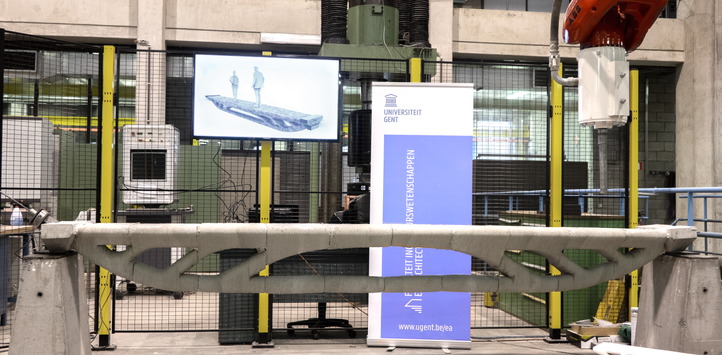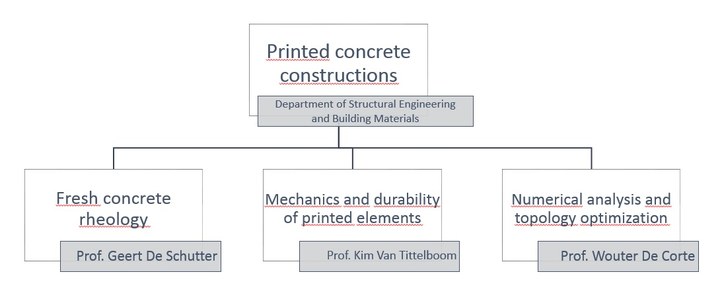An optimal concrete bridge
Researchers at the department of Structural Engineering (Ghent University) have made a bridge at lab scale with the smallest possible amount of concrete. This project was 3D printed in collaboration with Vertico, a Dutch firm that made a mobile 3D printer and Technion Israel Institute of Technology. The shape of the bridge was optimized and combined with an optimized trajectory of the steel cable at the bottom of the bridge to minimize stress peaks.

Concrete bridges have been printed before. There was the bicycle bridge in Gemert (The Netherlands) in 2017. There, the prismatic concrete elements were printed separately, tilted after hardening and finally pulled together by means of steel cables. This technique is common in traditional bridge construction but then the prismatic elements are typically casted in formwork instead of printed. This laborious first step is no longer necessary.
One of the major advantages of 3D printing is the freedom to create all kinds of smooth shapes. This is esthetically refreshing, but it also allows engineers to place concrete solely where it is needed the most. In this way, you reduce the material consumption and the construction time which both provide an ecological and economical advantage. The researchers started with a 3D model of the bridge and had algorithms search for the shape of the bridge that required the smallest amount of concrete. This appears not to be the well-known rectangular beam shape but a rather organic structure instead. Eventually, the topologically optimized model was sent to the concrete printer.

During printing of the bridge, the researchers provided a cavity in the bottom of the bridge to pull a cable through afterwards. After hardening of the bridge, this cable was gently tensioned to make sure that the weight of the bridge and future loads wouldn’t cause additional tensional stress in the concrete, which it can’t sustain very well. This technique also reduces the theoretically required amount of concrete to provide sufficient strength. Thanks to 3D printing, this material saving can now be actually employed.
The printing of a concrete bridge at lab scale fits the research ambition of the department of Structural Engineering because it allows to study different sides of the printing technology. The department is fully aware that this technique has real potential to break through and therefore deploys several researchers to cope with the many challenges specific to this technology. One of them is trying to combine the appropriate fluid behavior with the required mechanical properties of the hardened element.

Contact
If you are interested in this research or have an idea that you want to discuss, do not hesitate to contact the project leader
Gieljan Vantyghem
Concre3DLab: youtube.com/c/Concre3DLabGhent
This research project was supported by Ghent University, Vertico, and Technion - Israel Institute of Technology.
The following partners were involved:
- 2D Topology and shape optimization of the prestressed concrete girder: Technion - Israel Institute of Technology
- 3D modelling and FE-analysis: Research Group Schoonmeersen - Department of Structural Engineering - Ghent University
- Rheology mix design and manufacturing process: Mortar recipe from wiki.bouwkoppel.nl | dehuizenprinters - Vertico
- Assembly and post-tensioning: Magnel Laboratory for concrete research - Department of Structural Engineering - Ghent University